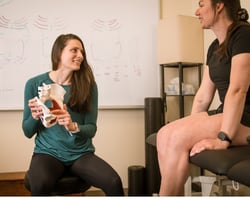What is the Pelvic Floor and Why Does it Matter?
What is the pelvic floor?
If you're reading this right now you're likely sitting on your pelvic floor.
The pelvic floor is located at the bottom of our pelvis, between our sit bones. It is a sling of muscles, tendons, ligaments, fascia, nerves, and vasculature that help hold our abdominal and pelvic organs in place.
If you think of the pelvis as a bowl, the pelvic floor is the bottom of the bowl. It runs front-to-back from the pubic bone to the tailbone, side-to-side between the sit bones, and extends up into the sidewall of the pelvis.

What makes the pelvic floor muscles unique?
In general, a healthy muscle is one that is able to contract, relax, and lengthen.
The pelvic floor is made up of skeletal muscle - we can contract and relax on demand just like our quad or bicep muscles. It also has autonomic function which is responsible for bowel and bladder control. Urination & defecation happen optimally when the pelvic floor muscles are relaxed - which should happen automatically when you sit on the toilet.
Have you ever noticed when you are stressed and find you have been clenching your jaw and your shoulders are raised up toward your ears - all without conscious thought to do so? This happens in the pelvic floor too. If the muscles are used to being in a tense state, it can become their new normal resting state.
You’ve probably heard “just do some kegels” to help pelvic floor issues. However, strength is not always what the pelvic floor needs! It may actually benefit from relaxation strategies via breath work & mobility exercises to regain its’ ability to lengthen.
Why is the pelvic floor so important?
When functioning properly, the pelvic floor works in conjunction with the muscles of the abdomen and diaphragm to play a large role in the stability of the torso, hip, and pelvis. When combined, these are often referred to as the "core canister."
What's so important about the "core canister?"
Our canister undergoes pressure during various movements and activities throughout our daily life, especially with exercise. It has to absorb and manage this pressure to be fully optimized.
A "strong core" can handle a lot of force and manage pressure well by distributing forces throughout this canister. Picture an aluminum can. If all sides of the can are not weak (or dented), then you could compress both ends of the can and it would be able to withstand a decent amount of force.
If there is a dent in the aluminum can, the can is not able to withstand as much force when compressing both ends towards each other. This corresponds to when our core is weak overall or in one specific area. The forces from activity are not absorbed as well, leading to pressure mismanagement and the leaking of pressure.
When pressure isn’t managed well and our core has reached it’s capacity, this pressure has to leak somewhere. We leak pressure by breathing out, developing a hernia, or by leaking urine or gas/stool.
The main functions of the pelvic floor:
Sphincteric:
The pelvic floor muscles have an important role in opening and closing to allow for urination and defecation. About 35% of our sphincter we can control - the rest is autonomic control - which is automatic.
Support:
A combination of the bones, muscles, and ligaments of the pelvic floor are quite literally holding our organs in place.
Sexual Function:
Our sex organs are housed within the pelvic floor. Pelvic floor contractions are involved in orgasm. Hypertonicity - heightened pelvic floor tension - can be an underlying cause of pain with intercourse.
Stability:
Our pelvic floor is working all of the time! Though these muscles are not primary movers (like the rectus abdominis / 6-pack muscle), we have a low level of activation throughout our pelvic floor even when standing still. Activities such as squatting and running require even more strength and stability.
Sump pump:
Similar to the calf muscle in the lower leg, the pelvic floor muscle contractions helps move blood and lymphatic fluid. Swelling and pelvic congestion can be a result of pelvic floor muscle dysfunction.
What diagnoses benefit from Pelvic Floor PT?
Injuries or conditions that are directly related to the pelvic floor include:
- Incontinence (either urinary or anal)
- A strong or frequent urge to urinate
- Pelvic organ prolapse
- Birth injuries such as perineal tearing, muscular avulsion, tearing and strain.
- Pelvic floor muscle tendinopathy
- Pudendal neuralgia
- Any individual who is pregnant or postpartum (postpartum is not just 12 weeks or 1 year, postpartum is forever!)
Some common orthopedic injuries where the pelvic floor can play a major role include:
- Hip Pain
- Low Back Pain
- Pelvic Girdle Pain
- SI joint
- Pubic symphysis
- Diastasis Rectus Abdominis (DRA)
- Abdominal and inguinal hernias
- Repetitive overuse injuries to the lower limbs
How do we know if our pelvic floor is functioning optimally with exercise?
Step one is having awareness of our pelvic floor: can you relax and contract your pelvic floor on demand? Does the pelvic floor relax and lengthen with a deep belly breath? What happens under load and how does it manage pressure? See what happens when you gently engage your core, and then more aggressively to lift a heavy weight. The pelvic floor should close and lift.
Aside from asking lots of questions, these are a few places I start when assessing the pelvic floor muscles in a performance based pelvic physical therapy exam. If you’d like to learn more about how your pelvic floor is functioning - an evaluation could be the next best step. Feel free to reach out to me at ashten@steadystatehealth.com with any questions!




